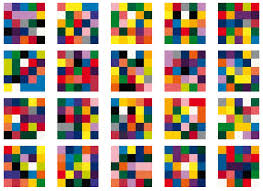Luck is probability taken personally
- Carol Anne Jones

- Oct 12, 2019
- 2 min read
Updated: Aug 24, 2020
This month I went to listen to a SAIC (school of the Art Institute of Chicago) presentation, as representatives are travelling the world during the autumn with the view to meeting prospective students. What was interesting was the SAIC’s commitment to experimentation and interdisciplinary thinking (STEAM - Science, Technology, Engineering, Art and Mathematics) and the interesting overlaps between the two areas of Art and Science that artists and designers are increasingly exploring. SAIC’s aim is to create a culture of creative thinkers from the arts and sciences who join together to combine their knowledge and abilities to come up with collaborative innovations.
So this got me thinking of this crossover in interdisciplinary practice.
An example of this crossover is Gerhard Richter’s 4900 Colours: Version II exhibited at the Serpentine Gallery, London in 2008,. Each display was made up of made up of 5 x 5 squares of colour. A computer program assigned a colour to each square drawn at random from a palette of 25 colours. The 196 panels were arranged at random in sets of 4 to form 49 10x10 displays. What was remarkable was how "non-random’" the panels looked, with some dominated by particular colours which are often placed next to each other.
Are these seemingly "non random" patterns a reflection of the randomness of life and what exactly is randomness anyway?
Randomness is defined as a lack of pattern or predictability in events. A random sequence of events doesn’t follow an intelligible pattern or combination and individual random events are by definition unpredictable, however in many cases the frequency of different outcomes over numerous events is predictable.
David Spiegelhalter is a statistician at the University of Cambridge and says that Mathematics can help us understand the role that randomness or chance acts play in the world around us. He concludes that chance events are based on probability that we cannot manipulate, and while these events are infrequent, our own attitude can produce positive outcomes. So by producing positive outcomes can we make our own luck and why are some people luckier than others? Is luck a mindset that we can all learn?
Richard Wiseman, innovative experimental psychologist and Professor of the Public Understanding of Psychology at Hertfordshire University, has made studies into this idea of luck. One of them involved 1000 exceptionally ‘lucky’ and ‘unlucky’ people. The people who considered themselves lucky always seemed to be in the right place at the right time, but the unlucky ones felt like things never worked out well for them. What he concluded was that, for the most part, they were creating their own good and bad luck from the way they were thinking and behaving. So, by convincing the unlucky people to think and behave like a lucky person, their luck might actually change. So here’s some tips on how to generate more luck in life; be more relaxed; be open to opportunities and make the most of them; be optimistic; use counter-factual thinking; be resilient and trust your intuition.
Now how’s that for a random monthly musing!
References:
Richard Wiseman
David Spiegelhalter
SAIC (school of the Art Institute of Chicago)
BBC iplayer









Comments